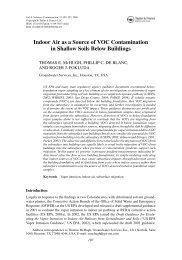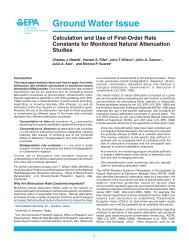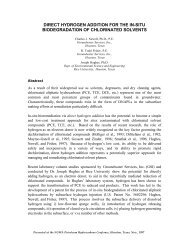Passive Soil Vapor Extraction - GSI Environmental Inc.
Passive Soil Vapor Extraction - GSI Environmental Inc.
Passive Soil Vapor Extraction - GSI Environmental Inc.
- No tags were found...
Create successful ePaper yourself
Turn your PDF publications into a flip-book with our unique Google optimized e-Paper software.
SRNL-STI-2009-00571Rev. 12.0 TECHNOLOGY DESCRIPTION2.1 Theoretical Basis2.1.1 Barometric <strong>Soil</strong> <strong>Vapor</strong> <strong>Extraction</strong>Fluctuations in the atmospheric pressure transmit through the soil as pressure wavesthat attenuate and decelerate with depth and lower soil permeability. This damping anddelay effect results in a sustained period of time during which the surface andsubsurface pressure are not in equilibrium. As a result, when the two zones are directlyconnected (as through a well), there is a dynamic flow of air from the zone of highpressure to the zone of low pressure (Figure 2.1), a process known as “barometricpumping”. When the atmospheric pressure is greater than the subsurface pressure,ambient air flows into the well. This principal forms the basis of passive bioventingtechnologies that are used to deliver oxygen/air to soils impacted with petroleumhydrocarbons. Exhalation or venting of soil gas, which forms the basis for PSVE, occurswhen the subsurface pressure is greater than the atmospheric pressure.Figure 2.1: Conceptual Model for the ‘Inhalation’ and ‘Exhalation’ Phenomenon Observed inWells Installed within the Vadose Zone.6 Enhanced Attenuation Technologies<strong>Passive</strong> <strong>Soil</strong> <strong>Vapor</strong> <strong>Extraction</strong>






